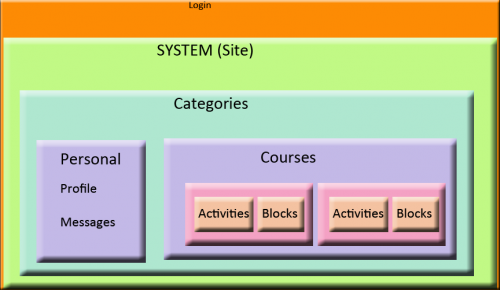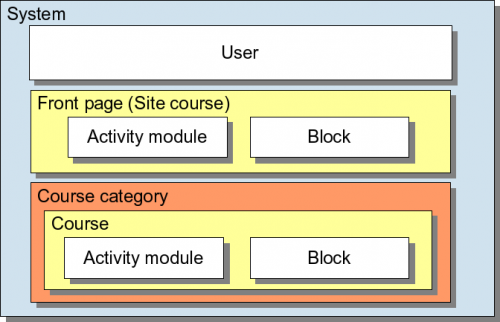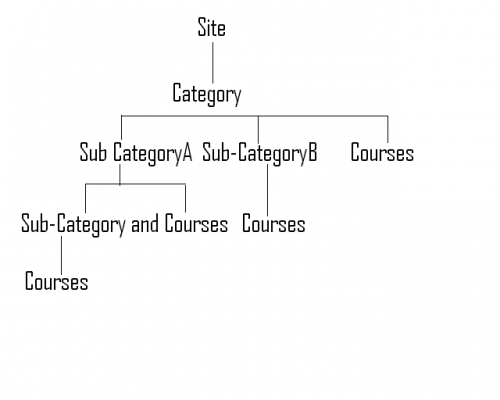Kontext: Unterschied zwischen den Versionen
| Zeile 34: | Zeile 34: | ||
(Source: [[Development:Roles#Context]]) | (Source: [[Development:Roles#Context]]) | ||
== | ==Eine weitere grafische Darstellung der Kontexthierarchie== | ||
[[File:Hierarchycategories.png| | [[File:Hierarchycategories.png|500px]] | ||
== Siehe auch == | == Siehe auch == | ||
Version vom 21. Februar 2019, 08:31 Uhr
![]() Diese Seite muss übersetzt werden.
Diese Seite muss übersetzt werden.
Es kümmert sich jemand darum, aber du darfst auch gern selbst mithelfen! Wenn du mit deiner Arbeit fertig bist, dann entferne die Vorlage {{ÜbersetzenVergeben}} aus dem Artikel.
Danke für deine Mitarbeit!
Ein Kontext ist ein Bereich in Moodle, in dem Rollen zugewiesen werden können. Zum Beispiel ist die gesamte Moodle-Site ein Kontext, die weitere Kontexte enthält. Ein Kursbereich ist z.B. ein solcher Kontext, der wiederum Kursunterbereiche und Kurse als Unterkontexte enthält.
Ein Kurs kann als Kontext Aktivitäten oder eine Fragensammlung mit Fragenkategorien oder Blöcke enthalten. Alle Beispiele zeigen, dass Kontexte weitere Unterkontexte enthalten können, und in jedem (Unter-)Kontext können Rollen zugewiesen werden.
Kontexte sind also hierarchich organisiert, und diese Hierearchie erleichtert die Suche nach einem bestimmten Bereich.
Die Hierarchie erlaubt es, dass untergeordnete Kontexte Informationen aus übergeordneten Kontexten übernehmen können. Zum Beispiel hat eine Person, die im Kontext eines Kurses A die Rolle Teilnehmer/in hat, diese Rolle auch im Unterkontext eines Tests B, der im Kurs A verfügbar ist. Oder wenn im Kontext eines Kursbereiches C ein bestimmtes Design zugewiesen wurde, dann gilt dieses Design auch in allen Unterkontexten, d.h. in allen Kursen dieses Kursbereiches C.
Rollen und Kontexte
A context is combined with role permissions to define a User's capabilities on any page in Moodle. Typically contexts have their own organization structure which allow a User's role to be passed along to the context "below" but not to the one above it.
It is possible to assign a user different permissions based upon a specific context. For example, a user might be given the role of "student" for a course but be given a teacher's role in the context of one specific forum. Or a user can be a teacher of one course and a student in another course.
Many Moodle contexts have a place to grant exceptions to specific roles within that context. Those exceptions are non-transferable from that context. That is, an exception can be applied to the next context downward, but cannot applied sideways nor upward from that context.
Grafische Darstellung der Kontexthierarchie
The image below shows a few contexts and their relationships. The "System" or Moodle site is the overall context. The user is defined initially in this context.
- The System context has 2 contexts under it, with other context under them
- The Front page context has
- An activity module context and
- A block context within it
- The Course Category context has
- A Course context within it. The course context has
- An activity module context and
- A block context within it
- A Course context within it. The course context has
- The Front page context has
(Source: Development:Roles#Context)


